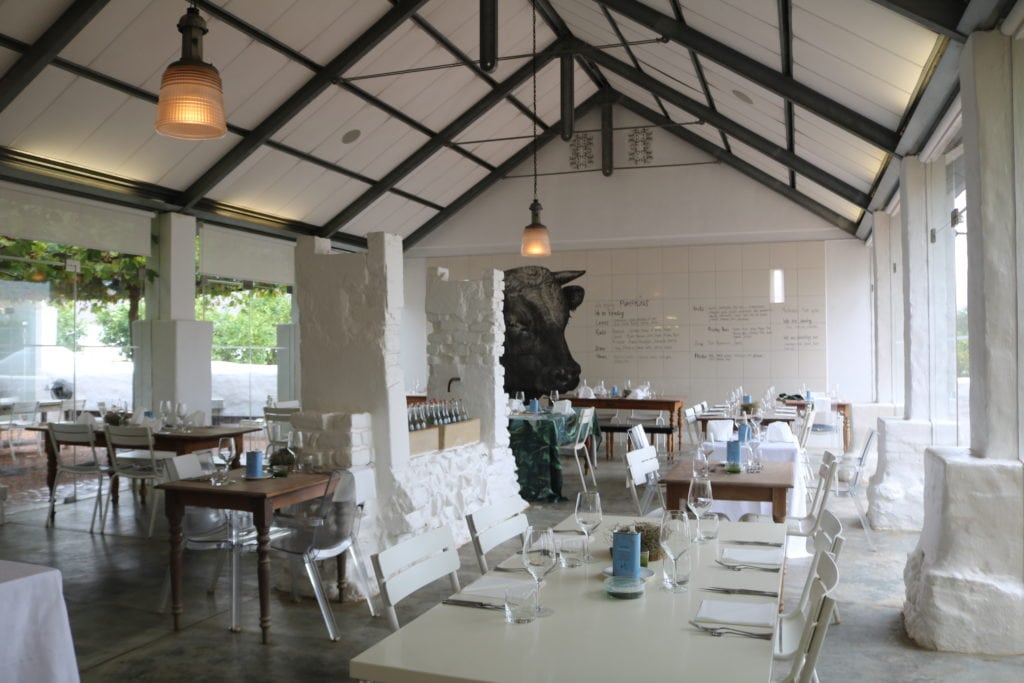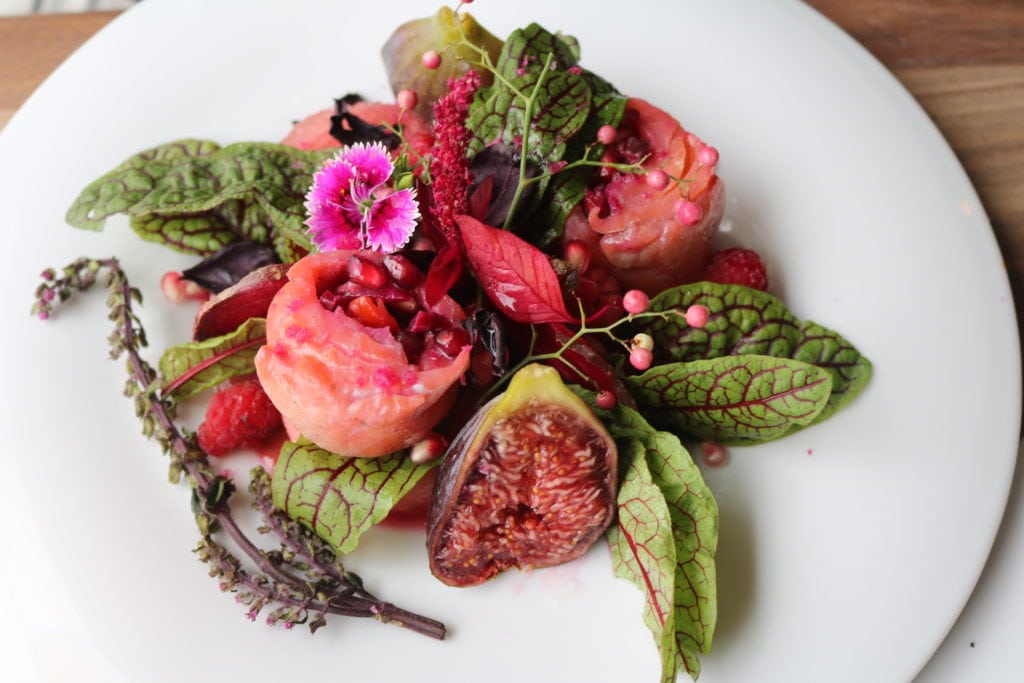Restaurants Flip the Script With Table-to-Farm Dining

Photo Caption: A waiter at Babel with the farm-fresh crudite offered to each table.
Skift Take
Opening culinary operations on farm grounds can be a risk, but -- when done well -- minimizes costs, lessens waste, and furthers consumers' dedication to local, ethically sourced cuisine.
Farm-to-table doesn’t always mean bringing the best of local farms’ produce to the restaurants. In fact, recently it’s meant the opposite with a new generation of farms taking advantage of consumers’ newfound dedication to local production and debuting restaurants of their own.
Any hospitality operation comes with challenges, but these farm restaurants have a particular set of obstacles to overcome. They are tasked with coordinating crops and cuisine and tailoring menus to seasonal availability all while balancing costs and communications.
Babel is perhaps one of the best examples of a farm restaurant. Set on one of South Africa’s more manicured gardens at Babylonstoren, the restaurant sources all of its vegetables, meats and cheese either directly from Babylonstoren’s 8.6 acre-garden, its external fields, or neighboring farms.
The restaurant is considered expensive by South African standards, with main plates generally around US $15-21 although Simone Rossouw, the food and beverage manager at Babylonstoren, says “the costs are quantified in experiences.”
The team at Babel has learned how to work with the entire growth cycle in creative ways, to maximize use of its on-site production.
For example, as artichokes begin flowering, its flowers are used before the full bloom. Young prickly pear leaves are used where prickly pears are not. The entire leek is used from stalk to root.
“We have learned to respect our harvest from beginning to the end… wastage is less and guests experience the full cycle of the plants within the garden,” said Rossouw.
Herbs are harvested daily while fruits and vegetables are harvested temporally for optimal ripeness. Larder also plays an important role, allowing the restaurant to preserve some of its best products for use throughout the year.
The economics, operations and communications behind Babel are integrally tied together and continually shifting.

The dining room at Babel.
“We had to adapt our service to customers as the farm grew. We had to expand Babel restaurant and adapt to working differently than other restaurants. It is much more difficult to get the gardener to harvest for the dining experience and get the kitchen to process products with soil so we did that first. Then we get guests to understand the fresh plates we serve and what makes it so fantastic,” said Rossouw.
An Approach to Hyper-Local Cuisine
In the northern hemisphere, another kind of farm restaurant is heading into its most abundant season.
The inn restaurant at Shelburne Farms in Vermont, is open from the middle of May to middle of October, which helps the restaurant — only daily —capitalize on prime farm production season.
Last year, 30 percent of its food costs came directly from the farm — vegetables, beef, lamb, syrup, and cheese — and a total 74 percent of food dollars were spent on Vermont-grown or Vermont-produced products.
The restaurant’s dedication to home-grown or locally-grown food and produce directly affects its costs.
“We generally see some savings with food grown directly on the farm, because we only pay production costs. The costs are generally higher for foods sourced from Vermont, rather than national brands, because we source from smaller farms and producers that are raising and making small batch, quality products,” explained James McCarthy, the executive chef at the Inn at Shelburne Farms.
McCarthy also gets creative with pricing to meet consumer expectations.
“We price at the going rate for a dish. Our beef, for instance, is relatively inexpensive to put on the plate, but it commands our highest price [$36] because that is what people are willing to pay. This allows us to source better ingredients from local farms and not charge more than diners are willing to pay. Our chicken is a premium product, but it is one of our more modestly priced items because we don’t think people will pay more for chicken than for beef.”
All-in-all, McCarthy estimates that food costs are approximately 30 percent — the industry standard.

The red summer salad at Babel.
Similarly, Vista Brewing outside of Austin, Texas, takes a hyper-local approach to cuisine.
The team made a significant investment in its organic farm, which now supplies more than half of all vegetables used in the beer garden and at events. Its dedication to high-quality local produce is not without challenges.
“Leveraging a hyper-local platform is a double-edged sword. We have daily access to fresh picked veggies but planning for peak ripeness and quantities available can be challenging. Working with our local farm and ranch partners offers similarly high-quality products, but just like any other business there are generally higher costs for sustainably produced goods in small quantities. One of the drivers for the industrial food engine that society has created is the sprint to high efficiency and low cost,” said Andrew Stiver, the chef at Vista Brewing.
Minimizing waste and making the use of the whole vegetable or animal is a critical element of making the economics at these farm restaurants work.
“Our menu reflects the use of whole animals in the kitchen. We don’t portion our proteins in the traditional sense — we only get two tenderloins per week, which wouldn’t feed all of our customers on a busy night,” said McCarthy.
“Over the years, we’ve moved towards ‘whole animal’ cuisine, where our dishes might consist of two to three different cuts of animal prepared different ways. We started doing that with our beef and lamb, and have progressed to the same style with our other menu offerings as well. This allows us to really showcase the animal in its entirety, while reducing waste.”
Stiver said there’s been a learning curve in sourcing adequate produce on a regular basis.
“Using a combination of smart harvesting, cold storage, and our relationships with our farm and ranch partners has helped create the right balance of fresh food while minimizing waste,” he said, echoing McCarthy’s message that preservation and pickling are critical steps to saving vegetables and proteins during times of abidance for use during learner months.
Ultimately, relationships within the community and communication between the internal team are the most important steps to making the economics of a new farm restaurant work.
“Passion is a great start, but the concept needs to be clear – everyone needs to understand the end goal and work/plan together,” said Babylonstoren’s Rossouw.
The gardener needs to know what the guest expectation is and needs to see the end result even before it’s plated by the chef.”

The travel industry's top event returns this fall.
September 16-18, 2025 - NEW YORK CITY
